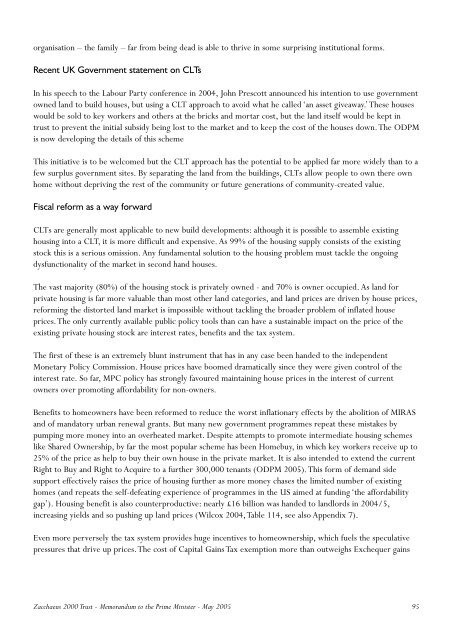Memorandum-to-the-Prime-Minister-on-Unaffordable-Housing
Memorandum-to-the-Prime-Minister-on-Unaffordable-Housing
Memorandum-to-the-Prime-Minister-on-Unaffordable-Housing
Create successful ePaper yourself
Turn your PDF publications into a flip-book with our unique Google optimized e-Paper software.
organisati<strong>on</strong> – <str<strong>on</strong>g>the</str<strong>on</strong>g> family – far from being dead is able <str<strong>on</strong>g>to</str<strong>on</strong>g> thrive in some surprising instituti<strong>on</strong>al forms.<br />
Recent UK Government statement <strong>on</strong> CLTs<br />
In his speech <str<strong>on</strong>g>to</str<strong>on</strong>g> <str<strong>on</strong>g>the</str<strong>on</strong>g> Labour Party c<strong>on</strong>ference in 2004, John Prescott announced his intenti<strong>on</strong> <str<strong>on</strong>g>to</str<strong>on</strong>g> use government<br />
owned land <str<strong>on</strong>g>to</str<strong>on</strong>g> build houses, but using a CLT approach <str<strong>on</strong>g>to</str<strong>on</strong>g> avoid what he called ‘an asset giveaway.’These houses<br />
would be sold <str<strong>on</strong>g>to</str<strong>on</strong>g> key workers and o<str<strong>on</strong>g>the</str<strong>on</strong>g>rs at <str<strong>on</strong>g>the</str<strong>on</strong>g> bricks and mortar cost, but <str<strong>on</strong>g>the</str<strong>on</strong>g> land itself would be kept in<br />
trust <str<strong>on</strong>g>to</str<strong>on</strong>g> prevent <str<strong>on</strong>g>the</str<strong>on</strong>g> initial subsidy being lost <str<strong>on</strong>g>to</str<strong>on</strong>g> <str<strong>on</strong>g>the</str<strong>on</strong>g> market and <str<strong>on</strong>g>to</str<strong>on</strong>g> keep <str<strong>on</strong>g>the</str<strong>on</strong>g> cost of <str<strong>on</strong>g>the</str<strong>on</strong>g> houses down.The ODPM<br />
is now developing <str<strong>on</strong>g>the</str<strong>on</strong>g> details of this scheme<br />
This initiative is <str<strong>on</strong>g>to</str<strong>on</strong>g> be welcomed but <str<strong>on</strong>g>the</str<strong>on</strong>g> CLT approach has <str<strong>on</strong>g>the</str<strong>on</strong>g> potential <str<strong>on</strong>g>to</str<strong>on</strong>g> be applied far more widely than <str<strong>on</strong>g>to</str<strong>on</strong>g> a<br />
few surplus government sites. By separating <str<strong>on</strong>g>the</str<strong>on</strong>g> land from <str<strong>on</strong>g>the</str<strong>on</strong>g> buildings, CLTs allow people <str<strong>on</strong>g>to</str<strong>on</strong>g> own <str<strong>on</strong>g>the</str<strong>on</strong>g>re own<br />
home without depriving <str<strong>on</strong>g>the</str<strong>on</strong>g> rest of <str<strong>on</strong>g>the</str<strong>on</strong>g> community or future generati<strong>on</strong>s of community-created value.<br />
Fiscal reform as a way forward<br />
CLTs are generally most applicable <str<strong>on</strong>g>to</str<strong>on</strong>g> new build developments: although it is possible <str<strong>on</strong>g>to</str<strong>on</strong>g> assemble existing<br />
housing in<str<strong>on</strong>g>to</str<strong>on</strong>g> a CLT, it is more difficult and expensive. As 99% of <str<strong>on</strong>g>the</str<strong>on</strong>g> housing supply c<strong>on</strong>sists of <str<strong>on</strong>g>the</str<strong>on</strong>g> existing<br />
s<str<strong>on</strong>g>to</str<strong>on</strong>g>ck this is a serious omissi<strong>on</strong>. Any fundamental soluti<strong>on</strong> <str<strong>on</strong>g>to</str<strong>on</strong>g> <str<strong>on</strong>g>the</str<strong>on</strong>g> housing problem must tackle <str<strong>on</strong>g>the</str<strong>on</strong>g> <strong>on</strong>going<br />
dysfuncti<strong>on</strong>ality of <str<strong>on</strong>g>the</str<strong>on</strong>g> market in sec<strong>on</strong>d hand houses.<br />
The vast majority (80%) of <str<strong>on</strong>g>the</str<strong>on</strong>g> housing s<str<strong>on</strong>g>to</str<strong>on</strong>g>ck is privately owned - and 70% is owner occupied. As land for<br />
private housing is far more valuable than most o<str<strong>on</strong>g>the</str<strong>on</strong>g>r land categories, and land prices are driven by house prices,<br />
reforming <str<strong>on</strong>g>the</str<strong>on</strong>g> dis<str<strong>on</strong>g>to</str<strong>on</strong>g>rted land market is impossible without tackling <str<strong>on</strong>g>the</str<strong>on</strong>g> broader problem of inflated house<br />
prices.The <strong>on</strong>ly currently available public policy <str<strong>on</strong>g>to</str<strong>on</strong>g>ols than can have a sustainable impact <strong>on</strong> <str<strong>on</strong>g>the</str<strong>on</strong>g> price of <str<strong>on</strong>g>the</str<strong>on</strong>g><br />
existing private housing s<str<strong>on</strong>g>to</str<strong>on</strong>g>ck are interest rates, benefits and <str<strong>on</strong>g>the</str<strong>on</strong>g> tax system.<br />
The first of <str<strong>on</strong>g>the</str<strong>on</strong>g>se is an extremely blunt instrument that has in any case been handed <str<strong>on</strong>g>to</str<strong>on</strong>g> <str<strong>on</strong>g>the</str<strong>on</strong>g> independent<br />
M<strong>on</strong>etary Policy Commissi<strong>on</strong>. House prices have boomed dramatically since <str<strong>on</strong>g>the</str<strong>on</strong>g>y were given c<strong>on</strong>trol of <str<strong>on</strong>g>the</str<strong>on</strong>g><br />
interest rate. So far, MPC policy has str<strong>on</strong>gly favoured maintaining house prices in <str<strong>on</strong>g>the</str<strong>on</strong>g> interest of current<br />
owners over promoting affordability for n<strong>on</strong>-owners.<br />
Benefits <str<strong>on</strong>g>to</str<strong>on</strong>g> homeowners have been reformed <str<strong>on</strong>g>to</str<strong>on</strong>g> reduce <str<strong>on</strong>g>the</str<strong>on</strong>g> worst inflati<strong>on</strong>ary effects by <str<strong>on</strong>g>the</str<strong>on</strong>g> aboliti<strong>on</strong> of MIRAS<br />
and of manda<str<strong>on</strong>g>to</str<strong>on</strong>g>ry urban renewal grants. But many new government programmes repeat <str<strong>on</strong>g>the</str<strong>on</strong>g>se mistakes by<br />
pumping more m<strong>on</strong>ey in<str<strong>on</strong>g>to</str<strong>on</strong>g> an overheated market. Despite attempts <str<strong>on</strong>g>to</str<strong>on</strong>g> promote intermediate housing schemes<br />
like Shared Ownership, by far <str<strong>on</strong>g>the</str<strong>on</strong>g> most popular scheme has been Homebuy, in which key workers receive up <str<strong>on</strong>g>to</str<strong>on</strong>g><br />
25% of <str<strong>on</strong>g>the</str<strong>on</strong>g> price as help <str<strong>on</strong>g>to</str<strong>on</strong>g> buy <str<strong>on</strong>g>the</str<strong>on</strong>g>ir own house in <str<strong>on</strong>g>the</str<strong>on</strong>g> private market. It is also intended <str<strong>on</strong>g>to</str<strong>on</strong>g> extend <str<strong>on</strong>g>the</str<strong>on</strong>g> current<br />
Right <str<strong>on</strong>g>to</str<strong>on</strong>g> Buy and Right <str<strong>on</strong>g>to</str<strong>on</strong>g> Acquire <str<strong>on</strong>g>to</str<strong>on</strong>g> a fur<str<strong>on</strong>g>the</str<strong>on</strong>g>r 300,000 tenants (ODPM 2005).This form of demand side<br />
support effectively raises <str<strong>on</strong>g>the</str<strong>on</strong>g> price of housing fur<str<strong>on</strong>g>the</str<strong>on</strong>g>r as more m<strong>on</strong>ey chases <str<strong>on</strong>g>the</str<strong>on</strong>g> limited number of existing<br />
homes (and repeats <str<strong>on</strong>g>the</str<strong>on</strong>g> self-defeating experience of programmes in <str<strong>on</strong>g>the</str<strong>on</strong>g> US aimed at funding ‘<str<strong>on</strong>g>the</str<strong>on</strong>g> affordability<br />
gap’). <strong>Housing</strong> benefit is also counterproductive: nearly £16 billi<strong>on</strong> was handed <str<strong>on</strong>g>to</str<strong>on</strong>g> landlords in 2004/5,<br />
increasing yields and so pushing up land prices (Wilcox 2004,Table 114, see also Appendix 7).<br />
Even more perversely <str<strong>on</strong>g>the</str<strong>on</strong>g> tax system provides huge incentives <str<strong>on</strong>g>to</str<strong>on</strong>g> homeownership, which fuels <str<strong>on</strong>g>the</str<strong>on</strong>g> speculative<br />
pressures that drive up prices.The cost of Capital Gains Tax exempti<strong>on</strong> more than outweighs Exchequer gains<br />
Zacchaeus 2000 Trust - <str<strong>on</strong>g>Memorandum</str<strong>on</strong>g> <str<strong>on</strong>g>to</str<strong>on</strong>g> <str<strong>on</strong>g>the</str<strong>on</strong>g> <str<strong>on</strong>g>Prime</str<strong>on</strong>g> <str<strong>on</strong>g>Minister</str<strong>on</strong>g> - May 2005 95




